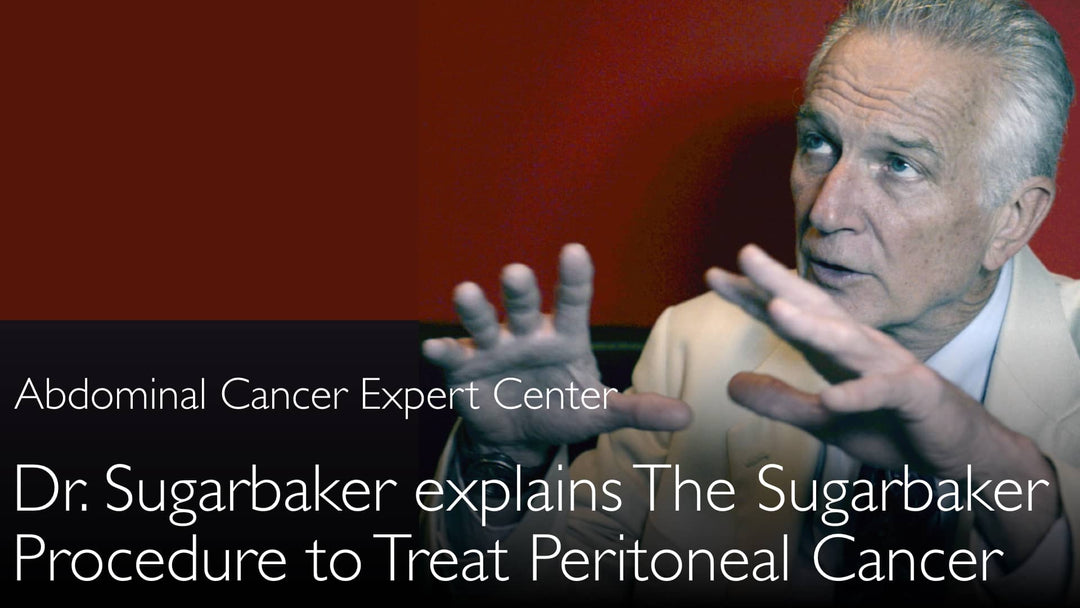Peritoneaalisen etäpesäkkeen hoidon johtava asiantuntija, lääketieteen tohtori Paul Sugarbaker, kuvaillee Sugarbaker-toimenpidettä. Tämä kehittynyt kirurginen menetelmä yhdistää sytoreduktiivisen leikkauksen ja lämmitetyn kemoterapian. Se tarjoaa mahdollisuuden parantumiseen vatsaonteloon levinneelle vaiheen 4 syövälle. Toimenpiteessä poistetaan huolellisesti kaikki näkyvät kasvaimet. Toisen ammatillisen lausunnon saaminen on ratkaisevan tärkeää diagnoosin varmistamiseksi ja hoitokelpoisuuden arvioimiseksi.
Edistynyt peritoneaalimetastaasien hoito: Sytoeduktioleikkaus ja HIPEC
Siirry osioon
- Sugarbaker-toimenpiteen yleiskatsaus
- Sytoeduktioleikkauksen tekniikka
- Parietaalisen peritonektomian prosessi
- Visceraaliset resektiot selitettynä
- Elektrokirurgia ja verenhukka
- Lääketieteellinen toinen lausunto
- Koko tekstitys
Sugarbaker-toimenpiteen yleiskatsaus
Sugarbaker-toimenpide on kattava hoitomuoto peritoneaalisiin etäpesäkkeisiin. Lääketieteen tohtori Paul Sugarbaker kehitti tämän yhdistelmähoitomuodon, joka yhdistää sytoeduktioleikkauksen ja hypertermisen intraperitoneaalisen kemoterapian (HIPEC). Sitä käytetään syöpien hoidossa, jotka ovat levinneet vatsaontelon pintakerrokseen. Näihin kuuluvat edistynyt paksu- ja peräsuolisyöpä, munasarjasyöpä, mahasyöpä ja umpilisäkkeen syöpä. Toimenpide on usein viimeinen parantava hoitovaihtoehto monille vaiheen IV syöpäpotilaille.
Sytoeduktioleikkauksen tekniikka
Sytoeduktioleikkauksen tavoitteena on poistaa kaikki näkyvät kasvainpesäkkeet vatsaontelosta. Lääketieteen tohtori Paul Sugarbaker korostaa, että syöpäpesäkkeiden perusteellinen poisto on keskeistä hoidon onnistumiselle. Tavoitteena on saavuttaa täydellinen sytoeduktio ilman makroskooppista sairautta. Tämä kirurginen toimenpide luo puhtaan alustan seuraavalle lämmitetylle kemoterapiahoidolle. Toimenpide palauttaa syöpämetastaaseilla peittyneen vatsaontelon lähes normaaliksi anatomiaksi.
Parietaalisen peritonektomian prosessi
Parietaalinen peritonektomia on Sugarbaker-toimenpiteen perusosa. Lääketieteen tohtori Paul Sugarbaker kuvailee sitä vatsan sisäseinämän "nahkaamiseksi". Kirurgit poistavat ainoastaan ne parietaalisen peritoneumin osat, joihin pahanlaatuinen prosessi on levinnyt. Parietaalinen peritoneumi on staattinen kerros ja yleinen kohde syöpäpesäkkeiden muodostumiselle. Tätä tekniikkaa seuraava kemoterapiapesu auttaa ehkäisemään syövän uusiutumista.
Visceraaliset resektiot selitettynä
Visceraaliset resektiot tarkoittavat syövän vaivaamien elinten tai niiden osien poistoa. Lääketieteen tohtori Paul Sugarbaker viittaa rakenteisiin kuten suolistoverkko, perna ja sappirakko "vatsaontelon varaosina". Potilaat eivät yleensä kaipaa näitä elimiä toipumisen jälkeen. Yleisiä resektioita ovat oikean paksusuolen poisto umpilisäkkeen syövän yhteydessä sekä suoran ja sigmasuolen poisto lantiosairauden hoidossa. Lantio on alennettu alue, jonne syöpäsolut useimmiten kerääntyvät painovoiman vaikutuksesta.
Elektrokirurgia ja verenhukka
Sugarbaker-toimenpide hyödyntää korkeajännitteistä elektrokirurgiaa perinteisen terävän leikkauksen sijaan. Lääketieteen tohtori Paul Sugarbaker selittää, että pallokärkisellä elektrokauteriointivälineellä höyrystetään syöpäsolut. Tämä tekniikka luo pienen lämmön nekroosimarginaalin, mikä mahdollistaa suhteellisen verettömän leikkauksen. Keskimääräinen verenhukka on huomattavan alhainen, noin kaksi yksikköä leikkauksen laajuudesta riippumatta. Tämä tarkka tekniikka on ratkaisevan tärkeää hyvin verisuonistetun peritoneaalin pinnan hoidossa.
Lääketieteellinen toinen lausunto
Lääketieteellisen toisen lausunnon hankkiminen on kriittinen vaihe peritoneaalimetastaaseja sairastaville potilaille. Lääketieteen tohtori Anton Titov korostaa, että toinen lausunto voi vahvistaa diagnoosin ja arvioida kelpoisuuden parantavaan hoitoon. Se auttaa varmistamaan, että tarkkahoito lähestymistapa valitaan edistyneelle munasarja-, paksu- tai mahasyövälle. Asiantuntijan, kuten lääketieteen tohtori Paul Sugarbakerin, konsultointi voi selventää, onko Sugarbaker-toimenpide sopiva vaihtoehto. Tämä vaihe on välttämätön monimutkaisten vaiheen IV syöpähoidon päätöksenteossa.
Koko tekstitys
Lääketieteen tohtori Anton Titov: Harvardissa koulutettu amerikkalainen syöpäkirurgi tohtori Paul Sugarbaker käsittelee nimensä saanutta metastaattisen peritoneaalisyövän hoitomenetelmää: Sugarbaker-toimenpidettä.
Sugarbaker-toimenpide koostuu sytoeduktioleikkauksesta ja hypertermisestä intraperitoneaalisesta kemoterapiasta (HIPEC), joka tunnetaan myös "kuumana kemokylpyynä" tai lämmitettynä kemoterapiana. Sugarbaker-toimenpide on usein viimeinen parantava hoitovaihtoehto metastaattisille vaiheen IV syöville, kuten paksu- ja peräsuolisyöpä, munasarjasyöpä ja mahasyöpä, jotka ovat levinneet vatsaontelon pintakerrokseen.
Peritoneaalisen metastaattisen syövän hoitoa selittää sen kehittäjä, lääketieteen tohtori Paul Sugarbaker. Paksu- ja peräsuolisyöpä, mahasyöpä ja munasarjasyöpä leviävät vatsaontelossa ja peritoneaaliavaruudessa.
Edistyneen vaiheen IV paksu- ja peräsuolisyövän peritoneaalimetastaasit hoidetaan sytoeduktioleikkauksella ja hypertermisellä intraperitoneaalisella kemoterapialla (HIPEC), kuumalla kemokylvyllä tai lämmitetyllä kemoterapialla. Peritoneaalisten syöpäpesäkkeiden perusteellinen poisto on keskeinen tekijä hoidon onnistumiselle.
Suoritetaan parietaalinen peritonektomia ja visceraaliset resektiot syöpävaurioituneista elimistä. Lääketieteellinen toinen lausunto selventää metastaattisen peritoneaalisyövän diagnoosia ja vahvistaa, että parantuminen on mahdollista metastaattisessa peritoneaalisyövässä.
Lääketieteellinen toinen lausunto auttaa valitsemaan tarkkahoidon vaiheen IV munasarjasyöpään, vaiheen IV paksu- ja peräsuolisyöpään tai metastaattiseen vaiheen IV mahasyöpään. On tärkeää hankkia lääketieteellinen toinen lausunto edistyneestä syövästä, jossa on peritoneaalimetastaaseja.
Paras hoito edistyneelle peritoneaalimetastaattiselle syövälle on kirurginen toimenpide. Tämä videohaastattelu on tohtori Paul Sugarbakerin kanssa, joka on johtava asiantuntija peritoneaalimetastaattisen syövän hoidossa, mukaan lukien sytoeduktioleikkaus ja hyperterminen intraperitoneaalinen kemoterapia (HIPEC), kuuma kemokylpy tai lämmitetty kemoterapia.
Peritoneaalisen metastaattisen syövän hoitoa selittää sen kehittäjä.
Lääketieteen tohtori Anton Titov: Tohtori Sugarbaker, te ja kolleganne kehititte vuosien ajan peritoneaalisyövän hoitomenetelmän, joka yhdistää sytoeduktioleikkauksen ja hypertermisen intraperitoneaalisen kemoterapian (HIPEC). Sitä käytetään monien vatsaontelon syöpien hoidossa: paksu- ja peräsuolisyöpä, munasarjasyöpä ja harvinaisemmat pahanlaatuiset kasvaimet kuten umpilisäkkeen syöpä.
Sytoeduktioleikkausta ja hypertermistä intraperitoneaalista kemoterapiaa (HIPEC) käytetään niiden syöpien hoidossa, jotka ovat levinneet vatsaontelon pintakerrokseen. Tämä toimenpide tunnetaan nykyään maailmanlaajuisesti Sugarbaker-toimenpiteenä.
Tohtori Sugarbaker, mikä on Sugarbaker-toimenpide?
Lääketieteen tohtori Paul Sugarbaker: Sugarbaker-toimenpide on yhdistelmä peritonektomiaa ja suoliston osien resektiota. HIPEC tarkoittaa sytoeduktioleikkausta ja hypertermistä intraperitoneaalista kemoterapiaa. Kutsumme näitä "visceraalisiksi resektioiksi".
Parietaalinen peritoneumi on peritoneumin ulompi kerros vatsaontelon peritoneaaliavaruudessa. Parietaalinen peritoneumi on staattinen; se ei liiku. Sisäelinten peritoneumi liikkuu koko ajan peristaltiikan vuoksi.
Tämä parietaalinen peritoneumi on alue, johon peritoneaalisen metastaattisen syövän pesiytyminen useimmiten kohdistuu. Yleensä ensimmäinen asia, joka meidän on tehtävä, on poistaa suuri määrä peritoneaalista metastaattista syöpää. Suoritamme parietaalisen peritonektomian toimenpiteen.
Parietaalinen peritonektomia on eräänlaista vatsan sisäpuolen nahkaamista. Emme nahkaa koko vatsan sisäpuolta; poistamme vain ne peritoneumin osat, joihin peritoneaalisyöpä on levinnyt. Jätämme jäljelle normaalit peritoneumin osat.
Pesemme pinnan peritonektomian jälkeen kemoterapialla. Tämä estää syövän kasvun.
Sytoeduktioleikkauksessa ja hypertermisessä intraperitoneaalisessa kemoterapiassa (HIPEC) suoritamme peritonektomian toimenpiteet. Todennäköisesti suurin panokseni sytoeduktioleikkaukseen on peritonektomian kuvaus. Kuvasin virallisesti viisi erilaista peritonektomiatoimenpidettä.
Niitä käytetään usein sytoeduktioleikkauksessa ja hypertermisessä intraperitoneaalisessa kemoterapiassa (HIPEC). Teemme parietaalisen peritonektomian. Sitten teemme visceraaliset resektiot.
Esimerkiksi saattaa olla tarpeen poistaa oikea paksusuoli, koska umpilisäkkeen syöpä sijaitsee siellä. Saattaa olla tarpeen poistaa suora- ja sigmasuoli, koska lantio on alennettu alue. Nämä peritoneaalisen syövän solut putoavat painovoiman vaikutuksesta lantioon.
Joskus lantio on alue, jossa on suuri määrä peritoneaalista syöpäsairautta. Ainoa tapa päästä eroon peritoneaalisesta syövästä on poistaa suora- ja sigmasuoli.
Suolistoverkko, perna, sappirakko, maksan pinnat – kaikki nämä elimet tai niiden osat voidaan poistaa. Kutsu niitä vatsaontelon varaosiksi. Potilas ei kaipaa niitä toivuttuaan leikkauksesta.
Sugarbaker-toimenpide on tämä peritoneumin resektioiden yhdistelmä. Sugarbaker-toimenpide käyttää korkeajännitteistä sähkökirurgiaa poistamaan peritoneaalista syöpää. Sitten käytämme standardimmaisia resektiotekniikoita.
Käytämme staplereita ja mesenteriumin resektiota poistamaan suoliston. Suorittamalla Sugarbaker-toimenpiteen saamme aikaan vatsaontelon, joka ennen toimenpidettä saattoi olla täynnä peritoneaalisyövän metastaaseja. Kun olemme suorittaneet sytoeduktioleikkauksen, et näe muuta kuin normaaleja vatsaontelon anatomiallisia rakenteita.
Lääketieteen tohtori Anton Titov: Ette käytä sytoeduktioleikkauksessa ja hypertermisessä intraperitoneaalisessa kemoterapiassa (HIPEC) tyypillistä terävää leikkausta. Käytätte tylppiä instrumentteja elektrokauterioinnin kanssa. Höyrystätte syöpäsolut.
Lääketieteen tohtori Paul Sugarbaker: Kyllä. Voit kuvitella, että leikkaat koko parietaalisen peritoneumin. Tuo parietaalinen peritoneumi liittyy moniin verisuoniin. Jos käytät perinteistä terävää leikkausta, verenvuoto tulee kaikkialle, missä työskentelet.
Sugarbaker-toimenpide johtaisi verenvuotoon. Oikea tekniikka on käyttää korkeajännitteistä leikkaavaa elektrokirurgiaa. Elektrokirurgia luo pohjimmiltaan pienen lämmön nekroosimarginaalin.
Elektrokauteriointi sytoeduktioleikkauksen aikana antaa vapa





